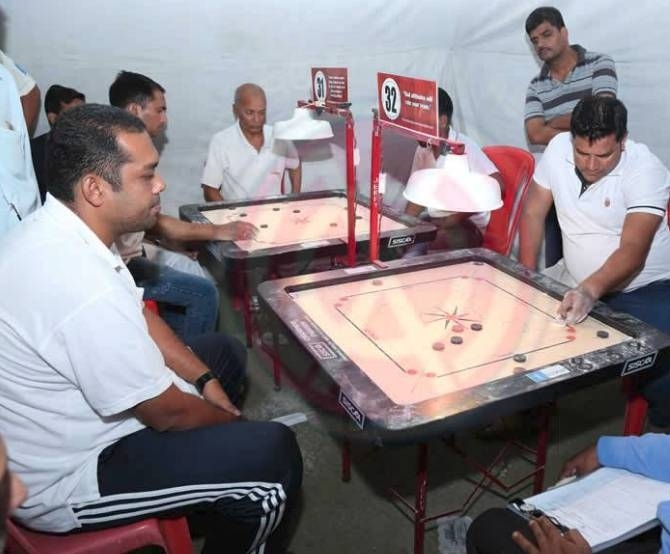Carrom (also spelled carom) is a cue sport-based tabletop game of South Asian origin. The game is very popular in India, Bangladesh, Afghanistan, Nepal, Pakistan, Sri Lanka and surrounding areas, and is known by various names in different languages. In South Asia, many clubs and cafés hold regular tournaments. Carrom is very commonly played by families, including children, and at social functions. Different standards and rules exist in different areas .
History
Carrom as we know it today has been played for nearly two hundred years, although games of a very similar nature have been played for thousands of years under a variety of names. Some believe it originated in India, while others link its origins to Portugal and even Burma. Carrom is spelled in many ways, including carom, carum, karom, and kairam; One may find this confusing, but it simply reinforces an underlying trend and nature of this game, where tradition and history reveal variety and differences. The history of thought and the history of carrom preceded the written word and we, therefore, have no record of it. The game lives through play, not necessarily dependent upon words.
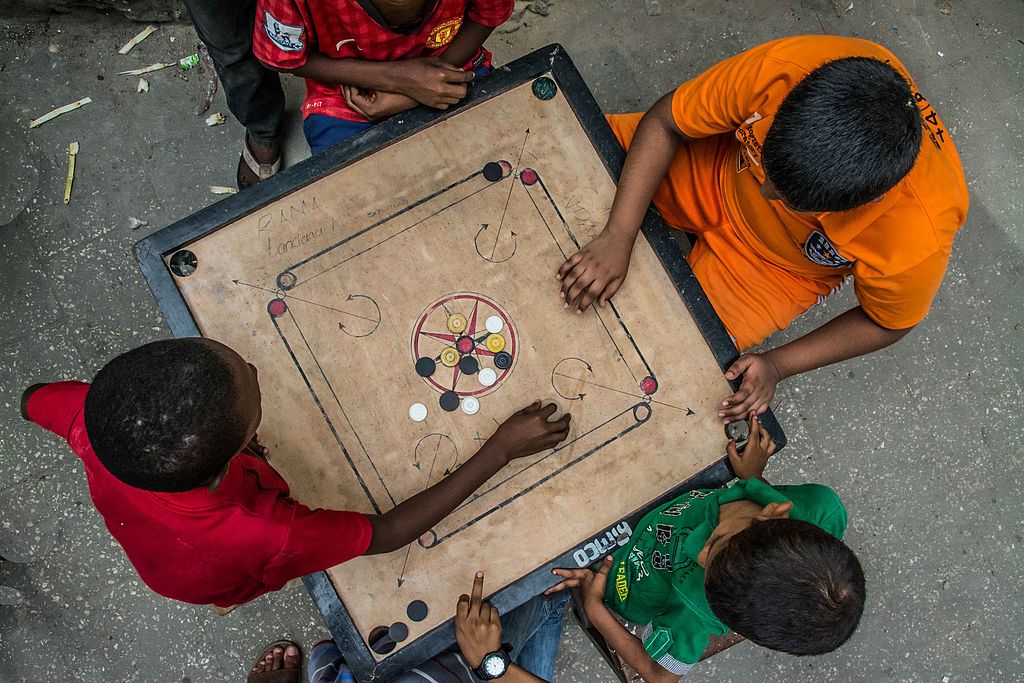
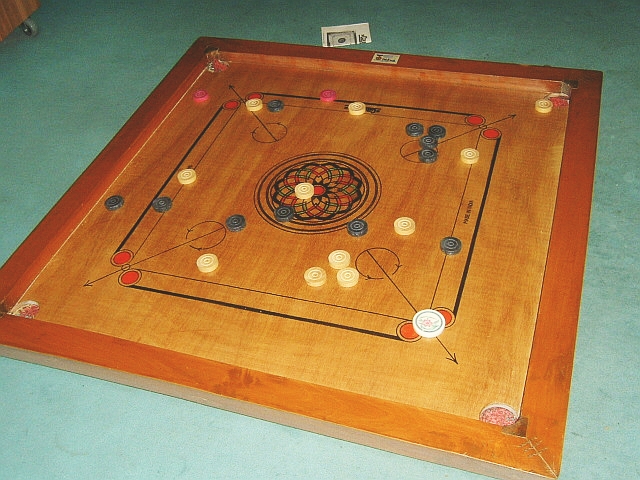
Rules
Most casual players would find the following simplified carrom rules quite useful to get started with the game. However, the formal professional Laws of Carrom adopted by the International Carrom Federation are also available if required.
Generally speaking, two or four people can play carrom. If two, the players sit opposite each other, while with four, the opposite two are partners. As an exception, though, you can play with three players against each other for points.
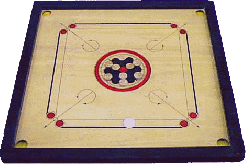
Game Start
Arrange the carrom men on the centre circle of the carrom board as shown in the following illustration, with the red ‘queen’ at the center. The whites should be lined up to form a “Y” shape, with two sides aiming directly towards the corner pockets.

Carrom Men Setup
Each player sits on his side of the board and can only strike from that side. The contestant playing white ‘breaks’ or plays first, which can be decided by the toss of a coin. The object of the game of carrom is to sink all of your carrom men, using the heavier ‘striker’, in any of the pockets before your opponent. Your turn continues as long as you keep sinking your carrom men – luck shots count and all combinations are permitted.
When placing the striker on the board to shoot, it must touch both ‘baselines’, either covering the end circle completely or not touching it at all. The striker may not touch the diagonal arrow line.
![]()
Correct Striker Placement
![]()
Incorrect Striker Placement

Index Finger

Middle Finger
Shooting styles are very personal – whichever ‘grip’ works for you is fine as long as you ‘flick’ the striker and don’t push it. Generally, it’s best to orient your body in order to see the line of your aim while shooting comfortably; you may not move or leave your chair.

Scissors Shot

Thumb Shot
For forward shots, you can use your index finger, middle finger, or even the ‘scissors’ shot. Before shooting, try touching the striker with your fingernail, to be sure that its really on the line. This will improve your accuracy and prevent you from hurting your finger.
For ‘back-shots’ you may only use your thumb or the scissors technique.
No part of your body, except your hand, may cross the imaginary diagonal line nor may your elbow protrude over the frame in front of you. Even your feet or knees my not leave your quadrant.

Incorrect Arm Position
The red ‘queen,’ can be pocketed at any time after sinking your first piece but must be sunk before your last one. After pocketing the queen, you must sink one of your carrom men, thereby ‘covering’ it, into any pocket in the next shot, or she is returned to the center spot.
Once the queen is covered, whoever clears all their carrom men first wins the ‘board’.
The winner of a board collects one point for each of the opponent’s carrom men left at the finish and three points for the queen if covered by the winner (if covered by the loser, no-one gets those points). No more points are collected for the queen after your score reaches 22.
A game consists of 25 points or eight boards, whichever comes first.
- Sinking the striker costs you one piece and your turn. But, if you sink a piece in the same shot, then two come up and you shoot again.
- After sinking the striker, your opponent places the due piece(s) within the center circle. If you haven’t sunk one yet, you owe one.
- If while shooting for the queen you also sink one of your carrom men in the same shot, the queen is automatically covered, no matter which went first.
- If a piece jumps off the board, it is placed on the center spot. If pieces land on end or are overlapping, they are left that way.
- If the center spot is partially covered when replacing the queen or a jumped piece, the piece should cover as much red as possible. If totally covered, the piece is placed opposite the next player behind the red spot.
- If you sink your opponent’s piece, you lose your turn. If you sink their last piece, you lose the board and three points.
- If you sink your last piece before the queen, you lose the board, three points and one point for each of your opponent’s pieces left.
- If the striker does not leave both lines, go again. You get three tries to break before losing your turn.
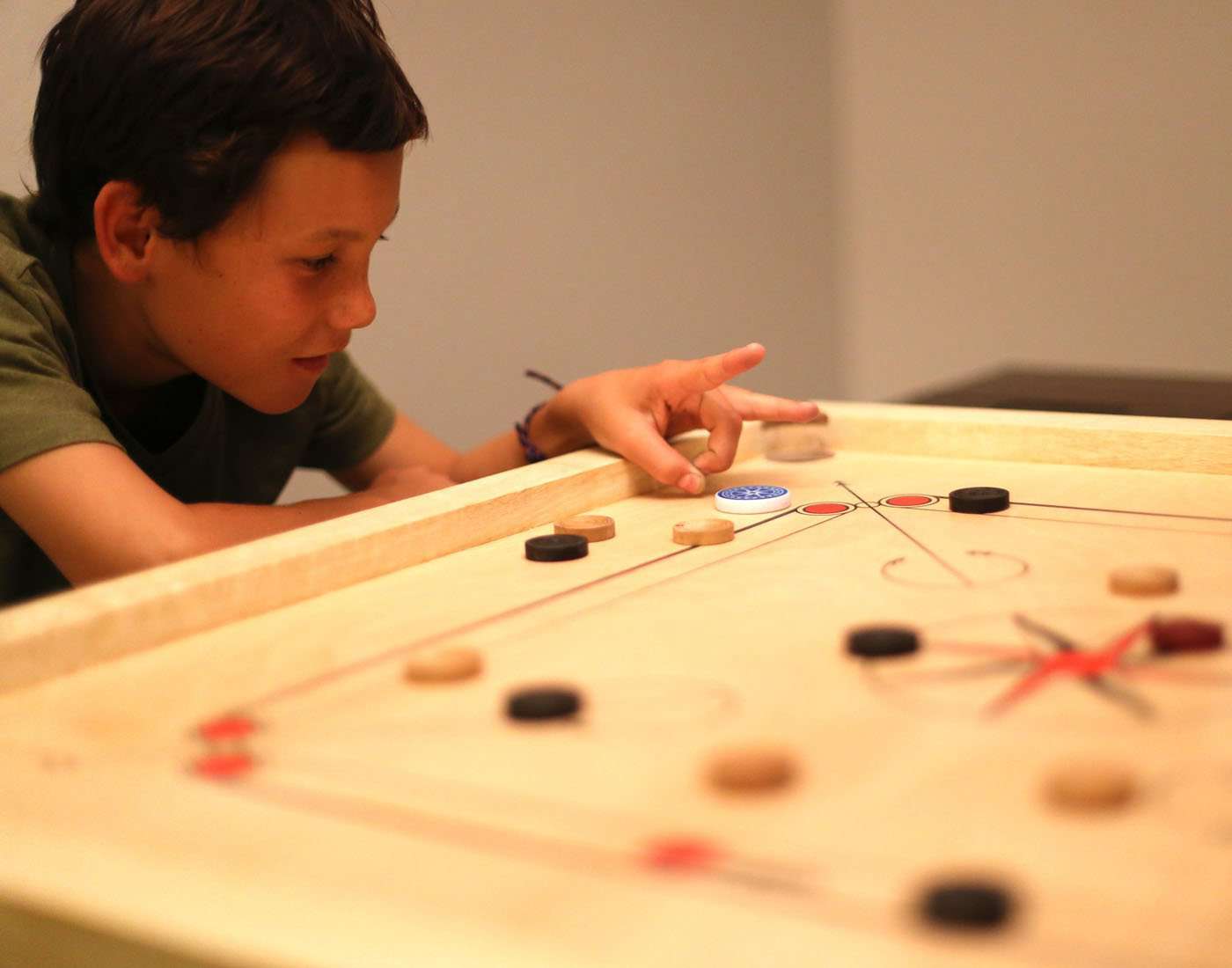
Equipment
-
Carrom Board
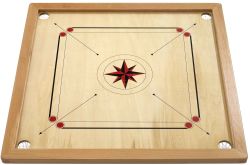
A square plywood board with a wooden frame and netted pockets in each corner.
The playing surface comprises of a square plywood board with screen printed lines and patterns, polished for a smooth low friction and hard wearing finish. The standard playing area is 74 cm x 74 cm i.e. 29″ square. However, smaller sizes are suitable for children while larger ones are great if you are already familiar with the game and want to try something different, albeit non-standard.
Boards come with different border frame widths, ranging from 1.25″ (about 32 mm) to 3.00″ (about 75 mm), with the thicker and heavier ones being more expensive and far better to play on due to better rebound or cannon effect generated.
 The four pockets or holes, one in each corner of the board, feature nets secured underneath to hold the pocketed carrom men or striker.
The four pockets or holes, one in each corner of the board, feature nets secured underneath to hold the pocketed carrom men or striker.
 Wooden bracing supports underneath the board’s surface, secured to both the plywood board and the border frame, reinforce the playing surface and avoid any warping.
Wooden bracing supports underneath the board’s surface, secured to both the plywood board and the border frame, reinforce the playing surface and avoid any warping.
-
Carrom Men
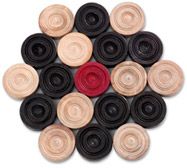
A set of nineteen light wooden or acrylic discs or coins (known as carrom men) – nine white, nine black and one red (known as the Queen).
While wooden carrom men are conventional, the recent acrylic or resin alternatives are lighter and less abrasive, thereby facilitating a faster game. However, if you’ve always played with wooden ones, it does take some time getting used to the acrylic ones – almost like driving an automatic car after years on a manual!
-
Carrom Striker
 An acrylic disc (larger and heavier than the coins) used to “strike” the coins.
An acrylic disc (larger and heavier than the coins) used to “strike” the coins.
There is such a wide variety of strikers available that selecting one in terms of physical appearance is a matter of personal choice. They come in all sorts of colours, ranging from ivory to black, with various illustrations, engravings etc. Since a poor striker can dampen the game altogether, it is important to go for quality ones with a smooth surface, for minimum friction and high impact.
-
Carrom Powder
 Carrom powder is sprinkled on the board’s surface to reduce friction, thereby enabling smoother and faster play.
Carrom powder is sprinkled on the board’s surface to reduce friction, thereby enabling smoother and faster play.
Broadly speaking, there are two basic types of carrom powder. The traditional commonly available powder is boric acid based, and works quite well to reduce friction. Also, few retailers now offer a new type of Telfon based super fine or “Disco” powder (usually available in small plastic bottles), which enhances performance significantly. It is important to understand that boric based powder works by reducing friction, while the “Disco” powder comprises of microspheres that act as rollers. Although the latter increases the speed noticeably, it is abrasive and can damage the board surface with prolonged use.
For optimum performance and longer life of your board, spray a small quantity of boric powder before each game, and never use two different types of powders simultaneously. If you wish to switch from one kind of powder to another, lightly wipe off the old powder with a soft cloth completely before using the new powder.
Associations
The US Carrom Association was formed in 1995 to promote the international sport of carrom in America. The goal of the USCA is to create a thriving carrom community in the US and to ensure US participation in the many international carrom tournaments and events organized by the International Carrom Federation or other National Carrom Associations around the world.
Current committee of USCA is
- President: Jayadev Suryadevara
- Vice President: Surya Mantena
- Treasurer: Shibu Jose
- Secretary: Aditya Chavali
- Joint Secretary: Srinivasan Rayaprolu.
The All India Carrom Federation (AICF) is India‘s national sport federation for the indigenous game of carrom, sanctioning six to seven national-level tournaments per year. It is India’s representative body in the International Carrom Federation. The AICF has 15 regional and 28 state subnational affiliate institutions, the largest of which is the Maharashtra Carrom Association, further subdivided into local organizations.
- The president of the federation (as of 2007) is Rakibul Hussain, and its general secretary is V. D. Narayan Recent national champions include M. Shankra, Ravinder Goudand A. Maria Irudayam.
